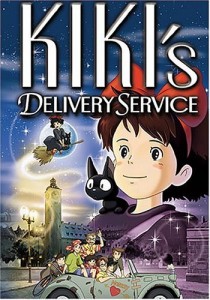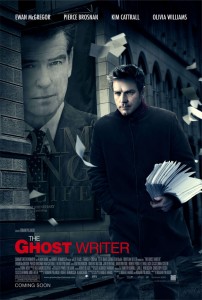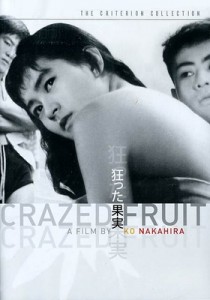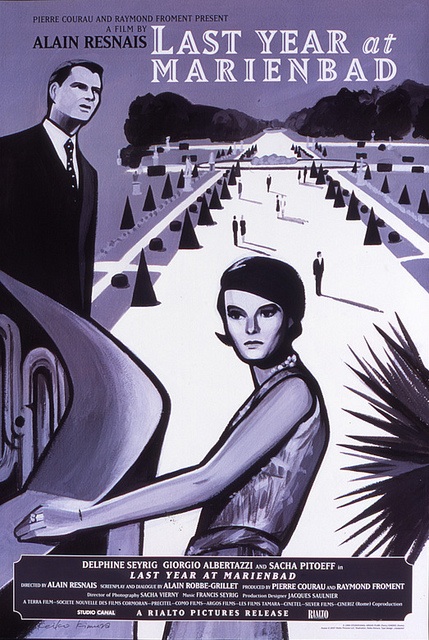
Titles I happened to check out on Netflix in the month of January 2011:
Last Year at Marienbad (1961) qualifies by me as one of the three weirdest movies ever made. But look at that year again: 1961 it was made. Could you have guessed something so out-there could have been made in that time period? The first half hour I was like, “I get the central joke, these people are barely more alive than mannequins,” a provocative joke but not enough to sustain my interest for the entire running time, I worried, and considered turning it off for good. Deeper thematic connections eventually occur, the slavering of the man and the bitchiness of the woman (and her unwillingness to be easily won over) are tip-offs, but they just barely lose their rigid aristocratic demeanor. This quintessential avante-garde piece is potentially solvable once you have enough time to settle in, and it is visually voluptuous and the camera movement is incomparably smooth and refined. But you may have to re-watch the film again in a year as I plan to, and bring a second pair of eyes with you. “Eraserhead” (1977, a great visionary nightmare) and “Zardoz” (1974, horrible but mesmerizing train wreck) are examples of other off the deep end oddities. If you live a century, then you have time to check out at least once the limitless possibilities of how strange the cinema can be. Patience-testing but if it works, the effects are hypnotic. French with English subtitles. A-
Hidden Fortress (1958) is one of Akira Kurosawa’s black and white samurai flicks, this one embedded in more humor than usual, although some of it can be grating. You strain hard to admire this film about lowly peasants (Minoru Chiaki and Kamatari Fujiwara) who are escapees from a prisoner of war chain-gain – the visual composition of their escape is nevertheless amusing. The two of them are persuaded to chaperon a general (Toshiro Mifune) and a princess (Misa Uehara, not talking in order to conceal her identity) across hostile territory in feudal Japan. Kurosawa’s breathless cuts in the fight scenes often surge with excitement. There are at least three elements to the film which can be traced to inspiration of George Lucas’ “Star Wars,” the wipe transitions are one of them. Often proclaimed a masterpiece, but let’s get a grip shall we? More a curious artifact, maybe a decent entertainment at best, than it is a thrilling entertainment. Japanese with English subtitles. B
The Hit (1984) is a trifle of a British mob movie by Stephen Frears (within a few years he made “Dangerous Liaisons” and “The Grifters”). Terence Stamp rats out his bank robber cronies and ten years later is found hiding out in Spain. John Hurt and Tim Roth, as the hardhearted veteran and the hotheaded rookie, are hitmen who go to collect him with the intention to bring him back to England for his execution in front of their boss. Stamp is taciturn cool, taking no sweat in his predicament, almost too willing to go along and informing he is not afraid of death because “we all go sometime.” Stamp is so quiet a majority of the time that it means that Hurt and Roth have to be the main attraction. There are several plot-changing stops and a kidnapping along the way (the babe has big boobs), leading to an unconventional conclusion pitting mercy versus duty. B-

Wow movie for really young kids but it is not impossible for an adult to be swept away by its pure innocence. Kiki’s Delivery Service (1989) is one of Hayao Miyasaki’s plot-lite but visually wonderful animated films. Miyasaki is the ultimate master of Japanese animation and after twenty years his films began reaching American audiences (“Spirited Away” is a must see in this lifetime). Kiki, a 13-year old witch in training on a flying broomstick, is encouraged to leave her small village to go find adulthood in a bigger city. City dwellers are mostly rude but she makes friends with one shopkeeper who lets her have a job delivering items to customers. The gut of the story teaches Kiki responsibility business, and how to juggle multiple difficulties in business. Tombo is the local boy with a big crush on Kiki. Cute and lavishly drawn. Dubbed in English. B
The Ghost Writer (2010) s a big brains Roman Polanski thriller. Less writing and more shuffling and pursuits than you would expect however. Ewan McGregor is the eponymous author – and man of transfixed integrity – assigned to finish the biography of former British Prime Minister Adam Lang (Pierce Brosnan) while on vacation in Martha’s Vineyard. Unseen people want certain installments of the biography to be emitted. Lang suddenly is under fire for consenting to war crimes connected to Guantanamo Bay, and becomes a media target. Film has all the elements of a “great film,” and a climactic image of a key message being passed between a chain of hands is superbly underlined. But for this critic it engaged the mind, held attention and plucked interesting thoughts – without ever exhilarating my heart. Good show, though. B
Mystery Train (1989) is a slow rhythm film by Jim Jarmusch, who composes an anthology of three stories that have a cause and effect on each other. Only the first story is of any interest, with Japanese lovers (Youki Kudoh and Masatoshi Nagase) who visit Memphis, Tennessee to get a load of Elvis’ old estate. The second story starts well with a con man (Tom Noonan) courting an out of towner (Nicoletta Braschi) at a diner with droll dialogue, but they get boring. Then Steve Buscemi and Joe Strummer show up in act three which eventually explains the gun that went off earlier (the three stories overlap in time). Jarmusch’s wry style of leaving characters out to wash can be stirring, emotive and captivating in their peculiarity – but with this film that only happens with act one. C-
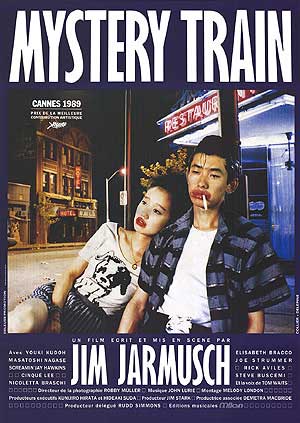
Aeon Flux (2005) puts Charlize Theron in a futuristic dominatrix look and reveals that Karyn Kusama is not a very good director, but as a director she certainly has creative-beserk ideas for set and costume design. This is a really bad movie, but sometimes you watch just to see how things cinematically can go wrong. In 2011, 99% of the world population was wiped out by a virus. Four centuries later, enclosed is a zoned community with extras wandering to one place to another, but you may be asking, “What do these people contribute on a daily basis to keep society going?” Theron, as the hero needed to unmask a major corporate-political conspiracy, is efficiently acrobatic but not that beautiful or sexy – her personality is so immalleable that she might as well turn her body into metallic. But the leaping stuff is neat-o. C-

Crazed Fruit (1956) has two teenage brothers in lust, and therefore competing, for a married Japanese woman who could care less in how promiscuous she is. It’s black & white, but it still connotes sensory sultriness. So this is how Japanese privilege appeared like in the mid-1950’s! The material is more blunt and progressive than most American movies of the same time period. The violence is stunningly edited. The brief sexuality manages to build an appetite. Japanese with English subtitles. B+

